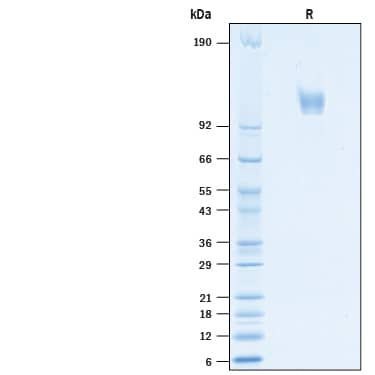Recombinant MERS-CoV Spike S1 (GCN4-IZ) His-tag Protein, CF
R&D Systems, part of Bio-Techne | Catalog # 10737-CV

Key Product Details
Product Specifications
Source
Human embryonic kidney cell, HEK293-derived mers-cov Spike S1 Subunit protein
| MERS-CoV Spike S1 Subunit (Tyr18-Pro747) Accession # YP_007188579.1 |
GCN4-IZ | 6-His tag |
| N-terminus | C-terminus |
Purity
>95%, by SDS-PAGE visualized with Silver Staining and quantitative densitometry by Coomassie® Blue Staining.
Endotoxin Level
<0.10 EU per 1 μg of the protein by the LAL method.
N-terminal Sequence Analysis
Tyr18
Predicted Molecular Mass
86 kDa
SDS-PAGE
105-125 kDa, under reducing conditions
Activity
Measured by its binding ability in a functional ELISA with Recombinant
Human DPPIV/CD26 (High Purity Dimer) (Catalog #
9168-SE).
Scientific Data Images for Recombinant MERS-CoV Spike S1 (GCN4-IZ) His-tag Protein, CF
Recombinant MERS-CoV Spike S1 (GCN4-IZ) His-tag Protein Binding Activity.
Recombinant MERS-CoV Spike S1 Subunit (GCN4-IZ) His-tag (Catalog # 10737-CV) binds Recombinant Human DPPIV/CD26 (High Purity Dimer) (9168-SE) in a functional ELISA.Recombinant MERS-CoV Spike S1 (GCN4-IZ) His-tag Protein SDS-PAGE.
2 μg/lane of Recombinant MERS-CoV Spike S1 (GCN4-IZ) His-tag (Catalog # 10737-CV) was resolved with SDS-PAGE under reducing (R) conditions and visualized by Coomassie® Blue staining, showing bands at 105-125 kDa.Formulation, Preparation and Storage
10737-CV
| Formulation | Lyophilized from a 0.2 μm filtered solution in PBS with Trehalose. |
| Reconstitution | Reconstitute at 500 μg/mL in PBS. |
| Shipping | The product is shipped at ambient temperature. Upon receipt, store it immediately at the temperature recommended below. |
| Stability & Storage | Use a manual defrost freezer and avoid repeated freeze-thaw cycles.
|
Background: Spike S1 Subunit
References
- Bermingham, A. et al. (2012) Euro Surveill. 17:20290.
- Zaki, A.M. et al. (2012) N. Engl. J. Med. 367:1814.
- Li, Y. et al. (2019) Engineering. 5:940.
- Raj, V.S. et al. (2013) Nature 495:251.
- Lu, G. et al. (2013) Nature 500:227.
- Wang, N. et al. (2013) Cell. Res. 23:986.
- Corti, D. et al. (2016) J. Infect. Public Health 9:231.
- Tang, X.C. et al. (2014) Proc. Natl. Acad. Sci. USA 111:E2018.
- Jiang, L. et al. (2014) Sci. Transl. Med. 6:234ra59.
Long Name
Spike Protein, S1 Subunit
Alternate Names
SARS-CoV-2
UniProt
Additional Spike S1 Subunit Products
Product Documents for Recombinant MERS-CoV Spike S1 (GCN4-IZ) His-tag Protein, CF
Product Specific Notices for Recombinant MERS-CoV Spike S1 (GCN4-IZ) His-tag Protein, CF
For research use only
